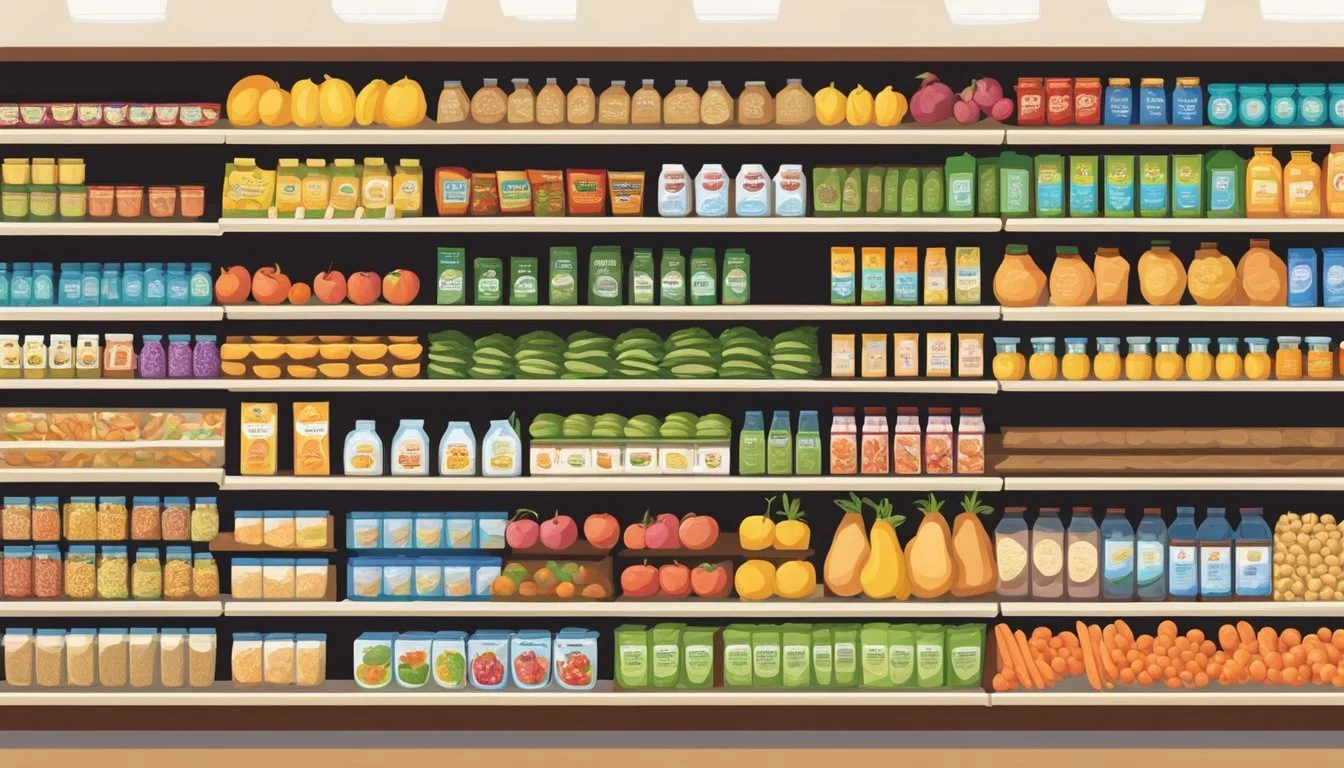Is Safeway Cheaper Than Trader Joe's?
Comparing Grocery Prices
Part of Our Grocery Store Guide with Details on Safeway Prices and Trader Joe's Prices
When comparing grocery chains, price often tops the list of considerations for shoppers. Safeway and Trader Joe’s stand out as two key players in the supermarket landscape, each with their own set of loyal customers and distinctive store brands. Looking into the pricing strategies and product offerings, Safeway tends to offer lower prices than Trader Joe's in various categories. Safeway, established as a large-scale grocery chain, provides a wide array of products from generic to premium brands, aiming to cater to a broad customer base with competitive pricing.
Trader Joe’s, on the other hand, operates on a different model, focusing heavily on private-label products and priding itself on a curated selection that emphasizes quality and unique offerings. While this approach might suggest higher prices, Trader Joe's often keeps costs down by eliminating middlemen and buying directly from suppliers. This way, consumers gain access to a selection of goods that balance cost and quality, though some specific categories like dairy have been found to be more expensive than at Safeway.
The pursuit of savings leads many shoppers to meticulously evaluate their grocery spending. It is typical to find Safeway as the budget-friendlier option across several shopping categories, such as beverages, canned goods, and personal care items. However, the choice between Safeway and Trader Joe's might not be solely dictated by the price tag. It also hinges on factors like store proximity, product preferences, and the overall shopping experience, which can sway a consumer's preference for one chain over the other.
Comparing Grocery Store Models
When analyzing the business models of grocery stores such as Trader Joe's and Safeway, it is evident that their approaches to retailing groceries diverge in several aspects. Trader Joe's operates as a specialty retail grocery store, emphasizing unique, private-label products that often cater to more niche health-conscious consumers. On the other hand, Safeway, part of the larger Albertsons chain, functions as a traditional supermarket, offering a wide range of national brand products alongside its own store brands.
Product Selection:
Trader Joe's: Narrow, curated selection of mostly private-label products.
Safeway: Broad assortment including private labels and national brands.
Pricing Strategy:
Trader Joe's: Generally offers lower prices for its store-brand items compared to national brands.
Safeway: Competes by offering a combination of weekly sales, promotions, and discounts.
Store Size and Layout:
Trader Joe's: Smaller store footprint with a straightforward layout designed for quick shopping experiences.
Safeway: Larger stores with more complex layouts, providing a variety of departments and services.
In comparison to warehouse clubs like Costco or discount retailers like Walmart and WinCo, both Trader Joe's and Safeway maintain a traditional grocery store experience but with different target markets and purchasing options. While Costco and WinCo focus on bulk purchasing and lower prices, Whole Foods, similar to Trader Joe's, targets health-conscious shoppers but at a premium price point.
Market Presence:
Trader Joe's: Operates with fewer stores nationwide, yet with a strong brand following.
Safeway: Part of a larger family of supermarkets, including Albertsons, with more extensive national coverage.
It is important to note that while prices may vary between Trader Joe's and Safeway, shoppers should consider the overall value, including product quality, shopping experience, and convenience, when deciding where to purchase their groceries.
Price Analysis
The section provides a detailed examination of how Safeway and Trader Joe's stack up in terms of pricing. It includes an approach to price evaluation, and concrete findings based on current price research data.
Overview of Price Comparison
Price comparisons between grocery stores help consumers make informed decisions by highlighting potential savings. A comprehensive analysis considers a range of products across various categories to determine which retailer offers the most economical options.
Methodology to Evaluate Prices
The methodology to evaluate prices involves gathering data on a set of commonly purchased grocery items. Researchers select identical or comparable store-brand products from each retailer, across several categories, to ensure a fair comparison. The prices are then tallied to ascertain the cost-effectiveness of shopping at one store over the other.
Category Safeway Price Trader Joe's Price Beverages $X.XX $X.XX Canned Goods $X.XX $X.XX Dairy $X.XX $X.XX Dry Goods $X.XX $X.XX ... ... ...
Note: Actual price figures to be inserted based on current data.
Findings from Price Research
Data indicates Safeway typically lands the more economic choice for categories such as Beverages, Canned Goods, Dairy, and Dry Goods. Conversely, Trader Joe's proves more advantageous in certain other areas. These findings suggest that savvy shoppers could optimize their grocery bill by selecting the right store based on the specific items needed.
With price differences evident, consumers stand to save greatly by choosing the right store. Those aiming for maximum savings should compare the prices of their specific shopping lists with the cost at both Safeway and Trader Joe's.
Quality of Goods
When comparing the quality of goods between Safeway and Trader Joe's, it's vital to consider the freshness and sourcing of produce, meat, and dairy. The quality of non-perishables also plays a significant role in a shopper's experience.
Comparison of Produce Quality
Trader Joe's has built a reputation for offering a selection of fresh produce, including fruits and veggies. Their products like spinach and potatoes often come from local suppliers when possible. Safeway, on the other hand, provides a wide range of produce, though the quality can vary significantly from store to store.
Trader Joe's Produce
Fruits: Often local or regional, seasonal selection
Veggies: Emphasis on organic and non-GMO options
Safeway Produce
Fruits: Wide variety, including exotic options
Veggies: Mix of conventional and organic, varies by location
Meat and Dairy Assessment
Trader Joe's meat selection is known for hormone-free and free-range options, with chicken breasts (What wine goes well with chicken breast?) and ground beef being customer favorites. Safeway offers a broader range, including meat, dairy items, and specialty cheeses, but the quality may fluctuate based on the supplier.
Trader Joe's Meat and Dairy
Chicken Breasts: Often free-range, antibiotic-free
Ground Beef: Typically hormone-free, grass-fed options
Cheeses: Curated selection of domestic and imported cheeses
Safeway Meat and Dairy
Chicken Breasts: Wide selection, varies in terms of free-range options
Ground Beef: Includes both standard and premium grades
Cheeses: Extensive variety, including budget and gourmet choices
Evaluating Non-Perishables
Non-perishable items like rice, cereal, and coffee are staples in any grocery store. Trader Joe's focuses on unique and health-conscious brands, which extends to items like dry goods and spaghetti. Safeway, with its larger footprint, tends to offer a broader range of national and store-brand grocery items.
Trader Joe's Non-Perishables
Dry Goods: Selection of health-conscious and ethnic specialties
Coffee: Fair-trade and organic selections available
Safeway Non-Perishables
Dry Goods: Comprehensive variety including bulk-bin options
Coffee: Wide range from budget-friendly to premium brands
Product Variety and Availability
When comparing Safeway and Trader Joe's, it's pertinent to scrutinize their product assortment and how readily the average shopper can find what they require. Each supermarket offers its unique set of strengths that cater to different customer needs.
Store Brands Vs. National Brands
Safeway is recognized for providing a balance between its own store brands and national brands. Their store brand, Signature Select, encompasses an ample range of products typically at a lower price point than national brands, without compromising on quality. Consumers can find store brand staples like bread and dairy, as well as a host of other grocery options.
In contrast, Trader Joe's heavily emphasizes its store brand products, which are often unique to its stores and may not be found elsewhere. Trader Joe's store brand is lauded for its quality and value, ensuring shoppers have access to a diverse selection, but with a less extensive range of national brands compared to Safeway.
Diverse Product Selection
Both Safeway and Trader Joe's boast diverse product selections that cater to various dietary needs and preferences. Safeway's shelves are stocked with a vast array of products, including organic, gluten-free, and international items. They offer a formidable range of supermarket staples, allowing shoppers to procure most of their grocery list in one trip.
Trader Joe's takes pride in its curated selection. It is less a traditional supermarket and more of a boutique grocery experience. They consistently introduce new, often globally-inspired, and specialty products. While their product range may not be as wide as Safeway's, they make up for it with exclusive items that keep their customers intrigued and coming back.
Discounts and Savings Opportunities
When it comes to finding the best prices at Safeway and Trader Joe's, consumers should be aware of the various discounts and savings opportunities each store offers. These can significantly reduce the overall shopping bill when utilized effectively.
Coupons and In-Store Promotions
Safeway frequently offers coupons and regular in-store promotions. Customers can find these deals through various channels including the store's weekly flyer, the Safeway website, and the Safeway mobile app. These coupons often apply to a wide range of products from pantry staples to personal care items.
Methods to access Safeway coupons:
Weekly flyers
Official website
Safeway mobile app
Trader Joe's takes a different approach, focusing on everyday low prices with fewer traditional coupons and promotions. The store doesn't issue weekly flyers or offer coupons through an app or website, aiming to provide consumers with savings without the need for additional discounts.
Reward Programs and Price Savers
Safeway provides a rewards program that allows consumers to accumulate points on purchases that can be redeemed for discounts on gas or groceries. The Safeway for U™ program provides personalized deals and offers based on the shopping habits of the customer.
Features of Safeway for U™:
Earn points per purchase
Personalized deals
Discounts on gas and groceries
On the other hand, Trader Joe's does not operate a traditional rewards program but their lower regular pricing can be seen as a built-in saver for consumers. They offer a curated selection of products, which helps them keep costs down and pass those savings onto their shoppers. The focus is on providing value through everyday pricing rather than a points-based savings system.
Shopping Experience and Convenience
When examining shopping experiences at Safeway and Trader Joe's, consumers consider layout and aesthetics along with the ease of finding and purchasing their groceries. These factors immensely affect the overall convenience of their shopping trip.
Layout and Aesthetics
Safeway and Trader Joe's differ significantly in store layout and design. Safeway follows a more traditional supermarket format, with well-organized aisles clearly labeled for different categories like dairy, baked goods, and frozen items. This chain strives for a clean and professional look, frequently offering a broad range of products including store brands.
Trader Joe's, in contrast, takes on an eclectic and playful theme, often featuring hand-drawn signage and a unique array of products. Their stores are smaller, which leads to a more curated basket of goods that focuses on the Trader Joe's brand. This can make finding common supermarket items a bit more straightforward for consumers, as there are fewer brand alternatives to browse through.
Ease of Grocery Shopping
Both Trader Joe's and Safeway prioritize convenience, but they approach it in different ways.
Safeway often provides a larger store with more selections, meaning consumers might find a wider variety of goods but could spend more time in the store if their basket is extensive.
Advantageously, many Safeway stores are open 24/7, which enhances shopping convenience.
The presence of self-checkout lanes allows for a quicker exit from the store.
Trader Joe's emphasizes an efficient and friendly grocery shopping experience.
With fewer choices, customers can quickly fill their basket with store brand items, aiding those who prefer a swift shopping trip.
Their employees are known for being approachable and helpful, which contributes to the ease of grocery shopping for those who may need assistance.
In conclusion, both Safeway and Trader Joe's deliver on convenience and a positive shopping experience through their unique approaches tailored to different consumer needs.
Dietary and Specialty Options
When shopping at Safeway and Trader Joe's, customers with specific dietary needs have a variety of options to consider. Both stores cater to alternative diets, but they differ in selection and availability of certain specialty foods.
Vegan and Vegetarian Choices
Safeway offers a range of vegan and vegetarian products throughout its stores. Shoppers can find items such as plant-based meats, dairy-free cheeses, and an assortment of vegan-friendly snacks. Their market basket can be quite diverse, including well-known brands alongside their own store brands.
Trader Joe's, known for its unique and often exclusive items, provides a selection of vegan and vegetarian grocery options as well. They frequently introduce new products, and their dedicated sections make it easy for those following a plant-based diet to shop without extensive label-checking.
Gluten-Free and Organic Selection
When it comes to gluten-free products, Safeway has a clear labeling system, and its shelves have a variety of gluten-free staples and snacks. The store typically has a dedicated section for these items, which is beneficial for consumers with celiac disease or gluten sensitivity.
Trader Joe's also supports a gluten-free lifestyle, with many of its products marked as gluten-free. Their private label ensures a trusted source for organic and gluten-free groceries. Both stores have taken strides to expand their organic selection, providing customers with options that range from fresh produce to pantry essentials.
Consumer Perceptions and Brand Image
When shoppers decide between Trader Joe’s and Safeway, they consider not only price but also the brand image and consumer perception of each store. Trader Joe’s boasts a strong brand image, recognized for its quirky, fun atmosphere, and unique product selection. Customers often associate Trader Joe’s with an enjoyable shopping experience and a place to find specialty items not available at other supermarkets.
Safeway, on the other hand, is perceived as a traditional grocery store, offering a wide variety of national and store brands. Shoppers see Safeway as a convenient, one-stop shop for all their grocery needs, including fresh produce, meats, and household items. Its brand image is aligned with providing a comprehensive shopping experience, which includes a familiar selection of brands that customers recognize and trust.
In contrast, Trader Joe's is known for its private-label products. These store brands are curated to deliver both quality and value, limiting the presence of national brands on its shelves. This strategy contributes to a perception of exclusivity and novelty—customers shopping at Trader Joe’s often expect to find goods that reflect current trends and health-conscious choices.
Brand Strategies:
Trader Joe’s: Private-label-focused, niche product offerings, trendsetting.
Safeway: Balance of national and store brands, broad selection, traditional.
The distinct brand strategies of each retailer cater to different consumer expectations, shaping the way shoppers perceive and engage with them. Safeway often attracts those seeking familiarity and a wide range, while Trader Joe’s appeals to those looking for a unique and differentiated product assortment.
Concluding Remarks
When consumers in the USA compare Safeway and Trader Joe's, cost efficiency is often a vital consideration. Safeway is generally the less expensive grocery store for a range of shopping categories, including Beverages, Canned Goods, Dairy, Dry Goods, and Personal Care items. In contrast, Trader Joe's has been perceived as pricier, but the experience may cater to a different consumer base who values their unique product offerings.
Markup comparisons:
Beverages: Safeway $1.25, Trader Joe's $1.39
Bread: Safeway $1.99 (not compared for Trader Joe's)
Canned Goods: Safeway $0.99, (not compared for Trader Joe's)
Dairy: Safeway $3.59, (not compared for Trader Joe's)
It's crucial for shoppers to factor in the price per unit and to consider the overall shopping basket. A generic basket comparison indicated that prices at Safeway could result in modest savings compared to Trader Joe's.
Shoppers should also consider the variety and quality of products, reflecting personal preferences and lifestyle choices. Safeway offers a broad range of conventional items, while Trader Joe's focuses on providing unique, often gourmet or organic, selections.
Ultimately, the choice between Safeway and Trader Joe's may extend beyond pricing alone and encompass shopping preferences, dietary needs, and the proximity of the stores. Each grocery store chain has its distinct advantages that cater to different segments of consumers.









